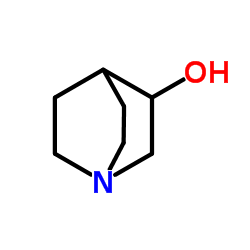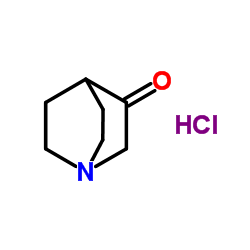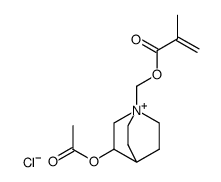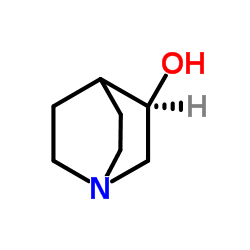Aceclidine

Aceclidine structure
|
Common Name | Aceclidine | ||
|---|---|---|---|---|
| CAS Number | 827-61-2 | Molecular Weight | 169.22100 | |
| Density | N/A | Boiling Point | 221.5ºC at 760 mmHg | |
| Molecular Formula | C9H15NO2 | Melting Point | N/A | |
| MSDS | N/A | Flash Point | 85ºC | |
Use of AceclidineAceclidine is a modulator of M3 muscarinic acetylcholine receptor. Aceclidine is a cycloplegic agent, a surfactant, a tonicity adjustor and optionally a viscosity enhancer and an antioxidant. Aceclidine has the potential for the research of disorders such as refractive errors of the eye, xerostomia, Sjogren's syndrome, glaucoma, conjunctivitis, lacrimal gland disease, and esotropia (extracted from patent US20150290125A1/US20110091459A1)[1][2]. |
| Name | 1-azabicyclo[2.2.2]octan-3-yl acetate |
|---|---|
| Synonym | More Synonyms |
| Description | Aceclidine is a modulator of M3 muscarinic acetylcholine receptor. Aceclidine is a cycloplegic agent, a surfactant, a tonicity adjustor and optionally a viscosity enhancer and an antioxidant. Aceclidine has the potential for the research of disorders such as refractive errors of the eye, xerostomia, Sjogren's syndrome, glaucoma, conjunctivitis, lacrimal gland disease, and esotropia (extracted from patent US20150290125A1/US20110091459A1)[1][2]. |
|---|---|
| Related Catalog | |
| Target |
M3 muscarinic acetylcholine receptor[1] |
| References |
| Boiling Point | 221.5ºC at 760 mmHg |
|---|---|
| Molecular Formula | C9H15NO2 |
| Molecular Weight | 169.22100 |
| Flash Point | 85ºC |
| Exact Mass | 169.11000 |
| PSA | 29.54000 |
| LogP | 0.58160 |
| InChIKey | WRJPSSPFHGNBMG-UHFFFAOYSA-N |
| SMILES | CC(=O)OC1CN2CCC1CC2 |
CHEMICAL IDENTIFICATION
HEALTH HAZARD DATAACUTE TOXICITY DATA
|
| Hazard Codes | Xi |
|---|---|
| HS Code | 2933990090 |
|
~90% 
Aceclidine CAS#:827-61-2 |
| Literature: Langlois; Meyer; Soulier Synthetic Communications, 1992 , vol. 22, # 13 p. 1895 - 1911 |
|
~60% 
Aceclidine CAS#:827-61-2 |
| Literature: Bracco International B.V. Patent: US5387409 A1, 1995 ; |
|
~% 
Aceclidine CAS#:827-61-2 |
| Literature: Helvetica Chimica Acta, , vol. 40, p. 2170,2176 |
|
~% 
Aceclidine CAS#:827-61-2 |
| Literature: Pharmaceutical Chemistry Journal, , vol. 18, # 3 p. 161 - 164 Khimiko-Farmatsevticheskii Zhurnal, , vol. 18, # 3 p. 297 - 300 |
| HS Code | 2933990090 |
|---|---|
| Summary | 2933990090. heterocyclic compounds with nitrogen hetero-atom(s) only. VAT:17.0%. Tax rebate rate:13.0%. . MFN tariff:6.5%. General tariff:20.0% |
| 3-Acetoxyquinuclidine |
| Quinuclidin-3-yl acetate |
| aceclidine |
| Glaucostat |




 CAS#:25333-42-0
CAS#:25333-42-0![1-Azoniabicyclo[2.2.2]octane,3-(acetyloxy)-1-(phenylmethyl)-, bromide (1:1) structure](https://image.chemsrc.com/caspic/342/41967-35-5.png) CAS#:41967-35-5
CAS#:41967-35-5
